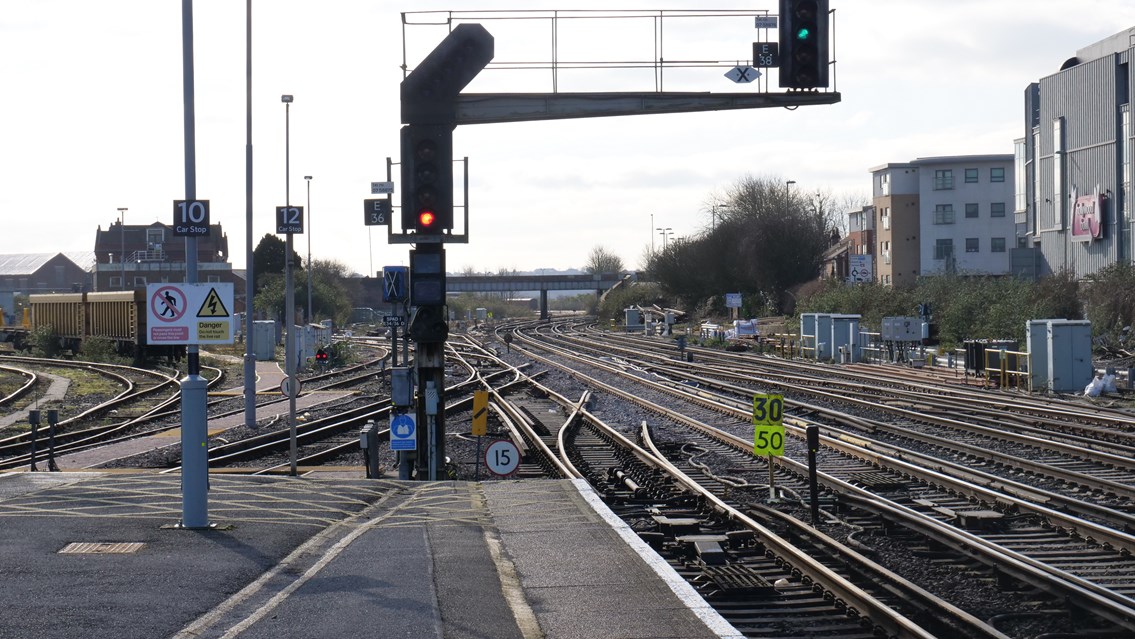Thursday 6 Feb 2020
Network Rail releases cause of freight train derailment at Eastleigh
- Region & Route:
- Southern: Wessex
The main railway line reopened through Eastleigh on Monday following the derailment of a freight train at the station and six days of emergency repair works.
Initial findings by Network Rail have found the cause of the incident to be an infrastructure fault, when a small number of fastenings gave way. This led to track spread - meaning that the two rails were no longer the correct distance apart.
This particular type of fastening is only used in a limited number of locations. Since the incident, Network Rail has conducted enhanced precautionary inspections of all similar fastenings across the Wessex route, with no additional areas of concern identified through this work.
During the incident teams worked around the clock to reopen the railway. Hydraulic jacks and cranes were used to lift the wagons back on to the track before they were removed from site.
The derailed train caused extensive damage to several sets of points, which allow trains to cross from one track to another. These had to be removed completely and a new set will be built off site to a bespoke design, this is expected to be delivered over coming weeks.
In the meantime, over 160 metres of temporary track has been laid to allow the reopening of the railway, however, without the critical points in place, not all trains can call at Eastleigh station. Passengers using Eastleigh station are advised to check www.southwesternrailway.com before travelling.
John Halsall, Network Rail Southern Region Managing Director said: “The railway through Eastleigh has been reopened. The derailment caused a phenomenal amount of damage to the rail infrastructure; we are working as quickly as we can to restore the full service and apologise to those whose journeys are still affected. A new set of points is being constructed from scratch as the old set were damaged beyond repair, this will take time and will be completed in the coming weeks.
“We now understand the cause of the derailment. A small number of fastenings holding the track to the rail gave way causing track spread and the two rails were pushed apart. Passenger safety is our top priority; we have conducted detailed inspections of all other locations across the route where similar fastenings are found and no additional areas of concern have been identified through this work.”
The official Rail Industry Accident Board (RAIB) investigation is ongoing and is fully supported by Network Rail.
Notes to Editors
The freight train derailed in the station on Tuesday, January 28.
Six 52-tonne wagons came off the rails and damaged 160m of track, two sets of points and sleepers.
Contact information
Passengers / community members
Network Rail national helpline
03457 11 41 41
Latest travel advice
Please visit National Rail Enquiries
Journalists
Network Rail press office - Chris Denham
Operational Communications Manager
020 3357 7969
07515 626530
chris.denham@networkrail.co.uk
About Network Rail
We own, operate and develop Britain's railway infrastructure; that's 20,000 miles of track, 30,000 bridges, tunnels and viaducts and the thousands of signals, level crossings and stations. We run 20 of the UK's largest stations while all the others, over 2,500, are run by the country's train operating companies.
Usually, there are almost five million journeys made in the UK and over 600 freight trains run on the network. People depend on Britain's railway for their daily commute, to visit friends and loved ones and to get them home safe every day. Our role is to deliver a safe and reliable railway, so we carefully manage and deliver thousands of projects every year that form part of the multi-billion pound Railway Upgrade Plan, to grow and expand the nation's railway network to respond to the tremendous growth and demand the railway has experienced - a doubling of passenger journeys over the past 20 years.
Follow us on Twitter: @networkrail
Visit our online newsroom: www.networkrailmediacentre.co.uk

